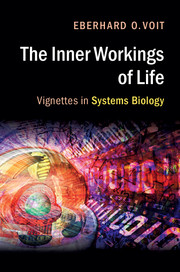Book contents
- Frontmatter
- Contents
- Appetizer
- Acknowledgments
- 1 Status: it's complicated!
- 2 I'd rather be fishin’
- 3 Whizzes and apparitions
- 4 Why?
- 5 Simply engenious!
- 6 Just a little bit
- 7 Supermodels
- 8 Close only counts in horseshoes and hand grenades
- 9 Emergence preparedness
- 10 Life without chaos?
- 11 What hath God wrought!
- 12 Tell me with whom you go and I'll tell you who you are
- 13 Time for a change!
- 14 Can't we all get along?
- 15 Love thyself and fight all others
- 16 A billion dollars for your thoughts!
- 17 The computer will see you now…
- 18 Redesigning perfect
- 19 Let's meet in the agorá!
- 20 Dessert
- Gentle jargon
- Selected further reading
- Index
11 - What hath God wrought!
Published online by Cambridge University Press: 05 May 2016
- Frontmatter
- Contents
- Appetizer
- Acknowledgments
- 1 Status: it's complicated!
- 2 I'd rather be fishin’
- 3 Whizzes and apparitions
- 4 Why?
- 5 Simply engenious!
- 6 Just a little bit
- 7 Supermodels
- 8 Close only counts in horseshoes and hand grenades
- 9 Emergence preparedness
- 10 Life without chaos?
- 11 What hath God wrought!
- 12 Tell me with whom you go and I'll tell you who you are
- 13 Time for a change!
- 14 Can't we all get along?
- 15 Love thyself and fight all others
- 16 A billion dollars for your thoughts!
- 17 The computer will see you now…
- 18 Redesigning perfect
- 19 Let's meet in the agorá!
- 20 Dessert
- Gentle jargon
- Selected further reading
- Index
Summary
On July 15, 2013, the last telegram was sent by the only remaining telegraph office in the world, the Central Telegraph Office in Janpath, India. The technology had lasted for almost two centuries, since the American artist and inventor Samuel Morse in 1837 first experimented successfully with an electrical telegraph. In 1844, he demonstrated the feasibility of his invention to the world, by sending the message “What hath God wrought” from Washington, DC to his colleague Alfred Vail in Baltimore. By doing so, he ushered in the era of the electrical and electronic information age.
The appeal of sending information across long distances is obvious and, of course, was not new even in Morse's time. The Estonian diplomat Pavel Schilling had demonstrated the feasibility of an electrical telegraph a few years earlier, and French engineers had operated light signaling systems since the late eighteenth century. Long before these inventions, Native Americans had been using smoke signals to warn their peers of impending danger.
Considering the enormous importance of knowing what's going on at a distance, it is not surprising that the transmission of information is an integral part of essentially all biological systems. The specific mechanisms of signal transduction within and between cells vary greatly in their molecular basis, transmission distance, time scale, and a number of other features. For instance, the speed of signal transduction ranges from electrical signals at the order of milliseconds to protein-based signaling cascades responding at the order of minutes and signals involving genomic and physiological responses that occur within tens of minutes, hours or even days.
In many cases, multiple signals are transmitted in parallel. For instance, the demand for a metabolite often triggers feedback signals directly at the metabolic level. These signals modify the activity of enzymes that are responsible for the synthesis of the desired metabolite. They accomplish this typically by slightly altering the physical shape of the enzyme molecules, which occurs within seconds. If this mechanism is insufficient, the availability or activity of other proteins may be changed, which takes minutes or hours. Persistent demands are signaled to the genome, where the expression of appropriate genes is up-regulated and secondarily leads to higher enzyme activities over longer time horizons that may span hours, days or weeks. Intriguingly, metabolic, protein-based and genomic alterations may all be initiated simultaneously.
- Type
- Chapter
- Information
- The Inner Workings of LifeVignettes in Systems Biology, pp. 82 - 89Publisher: Cambridge University PressPrint publication year: 2016



